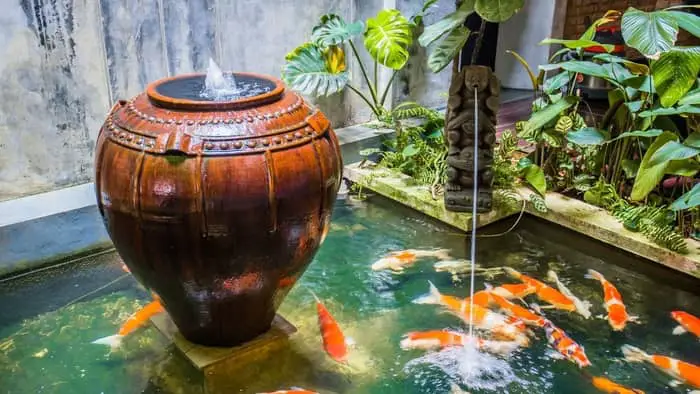Last Updated on November 9, 2021 by Marco C.
Koi is a beautiful and symbolic fish that many people love to raise in their home. If you are interested in building an indoor koi fish tank, you have come to a perfect place to learn all the important information that you need to know.
Often we can find Koi in outdoor ponds. For centuries, Koi Fish have been raised in monasteries and other spiritual places.
According to Canberra University, in Asian culture, they believe that Koi symbolizes perseverance, luck, courage, and strength. Koi are known for being able to swim upstream in very strong currents!
Also, their beautiful colors and patterns are mesmerizing to watch. They can be used as a tool in meditation. The name itself has its origins in Japan.
You can find many beautiful Koi ponds in Japan. It is a quite popular addition to restaurants and cafes. Even though its’ roots are in Japan, people also raise them all around the world.
Even though most of them are outdoors, you can easily make an indoor koi fish tank. This is particularly suitable in colder climates where it would be difficult to raise outside.
All About Indoor Koi Fish Tanks
Lucky for you Koi Fish are a very easy species to take care of! When you keep them indoors they will remain active all year. Usually, when they are outside the fish will go dormant for a period of time when the weather is cold.
Raising Koi indoors means you will have year-round beauty available inside your house! Koi are also very friendly and will happily eat directly from your hand.
Another interesting aspect about Koi is that they are adaptable. This means that they most likely will not outgrow your tank. They are resilient creatures.
As long as nothing major happens inside your tank, they are likely to survive. They can live in a large temperature range of 45-95 degrees Fahrenheit! But the most optimum temperature range is between 68-77 degrees F.
For the most part, you will need to set up your tank the same way you would set up any other tank. Make sure you have all the necessary components of a tank such as filters, pumps, plants, lights, etc.
You will need to choose the size of your tank based on how many koi you want to raise and the sizes of those specific Kois. The size of the Koi will depend on the age.
How Many Koi Per Gallon Of Water
As I mentioned, Koi are very resilient so you won’t likely face a problem with overcrowding. But, if you want to provide them with the most comfortable environment, you use the following numbers.
For a 15-20 gallon tank, you can keep around 6 Koi Fish, who are between 4-6 inches long. Or you can keep 3 larger Koi Fish (6-8 inches long).
A 40-gallon tank can keep around 15, 4-6 inch koi fish. Or 7 larger koi fish. Use these numbers as a general reference.
Setting Up Your Indoor Koi Fish Tank Site
The same as with any other tank system, you will need to find the perfect location for your tank. Keep in mind the dimensions of your tank and how many gallons of water your tank is. This will affect the weight of the tank.
Make sure you have a solid foundation to support the weight of the tank and its contents.
If you want to raise the healthiest Koi Fish, try to keep the temperature around 75F. Set up a thermometer in your tank to give you accurate measurements. If the water gets too cold you can do a water change with a slightly higher temperature.
Another way to control the temperature is to find a tank location that receives the appropriate amount of light. Too much direct sun can heat the tank up too fast! Overheating can also be caused by tank lights as well.
When you are first adding Koi into your tank, you can put them in a separate plastic bag to give them a chance to get used to the water temperature. Leave them there for at least 30 minutes before releasing them into your tank.
Once you have put your fish in the tank, you will have to feed them every day.
Koi Feeding Temperature Chart
Since Koi are cold-blooded fish, they are not able to control their internal body temperature. Therefore the temperature of the water will be the temperature of the fish. As the fish’s temperature changes with the water temperature, their body functions are affected.
Things like breathing and metabolism change depending on how hot or cold their environment is. This means it affects their eating patterns.
In general, the warmer the water means higher Koi activity and function. When the water is on the warmer side, you will need to feed them more. 70 degrees F or more means that you will need to increase the amount of food and the type of food.
With a higher metabolism, you want to give them foods higher in protein. Observe your fish to see how much they are eating and whether or not they are still hungry.
On the other hand, when the water temperatures decrease in the winter, Koi fish will not need to eat as much. Normally in the winter Koi fish go dormant to avoid expending energy and to store food over a long-term period of time.
As long as you don’t let your water temperatures drop below 65 degrees F, you shouldn’t need to worry about adjusting your feeding rates.
The best thing to establishing an indoor koi fish pond is maintaining a consistent temperature, keeping the water clean, and feeding them correctly. It’s really not that difficult! So why not go for it?
The beauty and peace that an indoor Koi fish tank brings is unrivaled. If you live in a cold climate, you can keep koi fish indoors all year long as long as you control the water temperature. The warm colors should help you get through the winter nicely.
Please feel free to comment and ask questions below!
Read more about: The Amazing Way How To Sterilize A Fish Tank

Candace is an aquaponics expert with over 5 years of experience in the field. She has a degree in environmental science from the University of California, Berkeley and a degree in aquaponics from the University of Florida. She is passionate about sustainable agriculture and has a deep knowledge of aquaculture and hydroponics. She has worked on numerous projects and has been involved in the development of aquaponic systems and fish farms. She also has experience in designing and constructing aquaponic systems. With her expertise, Candace is able to advise clients on the most effective and efficient way to construct and manage their aquaponic system. She is an active member of the aquaponic community, often speaking at conferences and seminars. Candace is dedicated to helping others understand the importance of aquaponics, and she is a strong advocate for sustainable food production.

